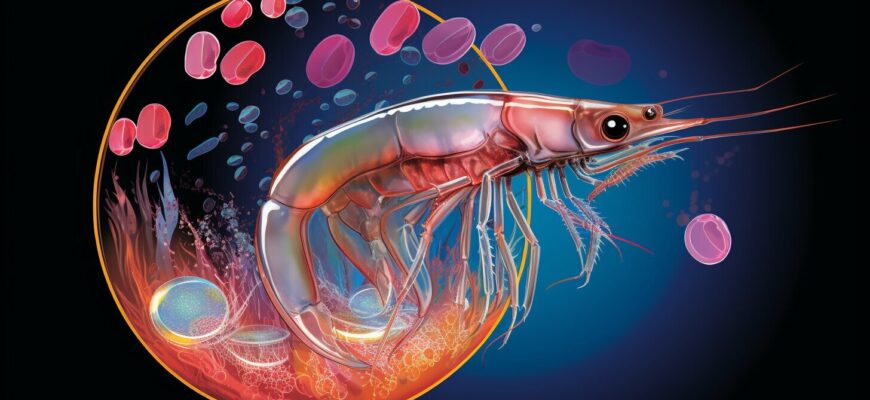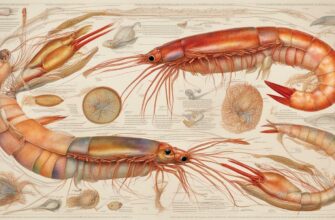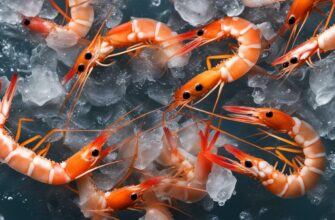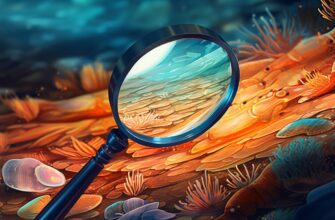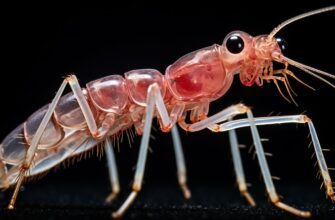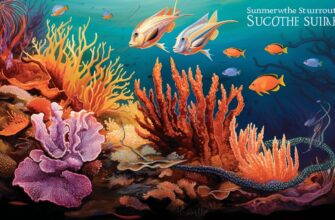Shrimp are fascinating creatures that play a significant role in aquatic ecosystems and human consumption. Understanding their reproductive process is crucial to ensure the sustainability of their populations and the maintenance of sustainable fisheries.
One of the most common questions people have about shrimp is whether they lay eggs. In this article, we will delve into the fascinating world of shrimp reproduction, exploring the different stages of their life cycle, the egg production process, and the factors that can affect successful reproduction.
Join us on this journey of discovery as we explore the nitty-gritty of shrimp reproduction, answering your most pressing questions about their mating behavior, larval stage, and environmental factors that can affect their survival. Let’s dive in!
- Understanding Shrimp Reproduction
- The Shrimp Life Cycle
- The Role of Reproduction in Shrimp Populations
- The Importance of Understanding Shrimp Reproduction
- Shrimp Egg Production
- Shrimp Egg Development
- Shrimp Larval Stage
- Shrimp Reproduction Strategies
- 1. Mating Behavior
- 2. Hermaphroditism
- 3. Reproductive Synchronization
- 4. Fertilized Egg Production
- 5. Reproductive Output
- Environmental Factors Affecting Shrimp Reproduction
- Temperature
- Salinity and Water Quality
- Habitat Degradation and Destruction
- Commercial Shrimp Farming and Reproduction
- Shrimp Reproduction and Sustainable Fisheries
- Shrimp Reproduction Research and Conservation Efforts
- Frequently Asked Questions (FAQs) about Shrimp Reproduction
- Q: Do all shrimp lay eggs?
- Q: How many eggs can a female shrimp lay?
- Q: How long does it take for shrimp eggs to hatch?
- Q: What is the lifespan of a shrimp?
- Q: What are the optimal mating conditions for shrimp?
- Q: How important is genetic diversity in shrimp farming?
Understanding Shrimp Reproduction
Shrimp reproduction plays a crucial role in the survival and growth of shrimp populations. The shrimp life cycle consists of several distinct stages, each with its own unique characteristics and challenges.
The Shrimp Life Cycle
The shrimp life cycle begins with the release of eggs by female shrimp. These eggs hatch into larvae, which go through several developmental stages before becoming post-hatchlings. Post-hatchlings then grow into adult shrimp, which are capable of reproducing and perpetuating the life cycle.
During the early stages of the life cycle, shrimp larvae are vulnerable to predators and changes in their environment. It is essential for shrimp populations to have a healthy and stable environment to ensure successful reproduction and survival.
The Role of Reproduction in Shrimp Populations
Reproduction is critical to the growth and sustainability of shrimp populations. In the wild, shrimp populations rely on successful reproduction to maintain their numbers and support the larger ecosystem.
In commercial shrimp farming, reproduction is essential for maintaining a steady supply of shrimp for human consumption. Shrimp breeding techniques have been developed to maximize reproduction rates and improve the quality of farmed shrimp.
The Importance of Understanding Shrimp Reproduction
Understanding shrimp reproduction is essential for effective management and conservation of shrimp populations. By studying the reproductive biology of shrimp, scientists and fishery managers can develop strategies to maintain sustainable fisheries and protect shrimp habitats.
Effective management strategies for sustainable fisheries include monitoring shrimp populations, implementing fishing regulations, and controlling environmental factors that can impact reproduction.
Overall, gaining a deeper understanding of shrimp reproduction is essential for ensuring the long-term viability of shrimp populations and the sustainability of shrimp fisheries.
Shrimp Egg Production
Female shrimp produce eggs through a process known as oviposition, which involves the release of mature eggs from the ovaries into the water. The exact amount of eggs laid varies by species, with some shrimp producing a few hundred to several thousand eggs per reproductive cycle. Interestingly, the number of eggs produced by female shrimp increases with their body size and age.
The egg-laying behavior of female shrimp is influenced by several factors, including water temperature, water quality, and photoperiod (the amount of light and dark in a 24-hour period). For instance, shrimp tend to lay fewer eggs in water that is too cold or too warm. In addition, they prefer water with a certain level of salinity and dissolved oxygen for optimal reproductive success.
Male shrimp play a crucial role in the reproductive process by transferring sperm to the female during mating. This fertilizes the eggs and enables them to develop into larvae. However, despite the importance of male shrimp, their role in reproduction is often overshadowed by that of females.
Shrimp Egg Development
Once the female shrimp lays her eggs, they begin the process of embryonic development. The development of shrimp eggs is divided into several stages.
The first stage is the cleavage stage, where the egg undergoes cell division. Then, the embryo enters the gastrula stage, where it starts to take shape. In the next stage, known as the nauplius stage, the embryo develops into a free-swimming larva known as a nauplius. After this stage, the embryo goes through several more larval stages before reaching the post-larval stage, also known as the juvenile phase.
Throughout this process, the eggs need to be in a controlled environment with the right water temperature, salinity, and oxygen levels to support healthy development. Environmental factors such as pollution, habitat degradation, and changes in water temperature can significantly impact egg development and ultimately the success of shrimp reproduction.
Shrimp Larval Stage
After hatching from their eggs, shrimp enter the larval stage, which is the most critical period in their development. At this stage, shrimp larvae are highly vulnerable to predators and environmental stressors. They are also unable to feed on their own and rely on their yolk reserves for sustenance.
During the larval stage, shrimp undergo a series of molts, shedding their outer exoskeleton to grow larger. As they grow, they begin to develop more complex structures, such as eyes, a digestive system, and fins. They also start to swim actively in the water column and respond to changes in light and temperature.
The larval stage lasts for about 1-2 weeks, after which shrimp enter the post-larval stage, where they begin to resemble their adult counterparts. At this stage, they can start feeding on small particles in the water and are more mobile and less vulnerable to predation.
Successful larval development is essential for maintaining healthy shrimp populations. Factors such as water temperature, salinity, and water quality can significantly impact shrimp larvae’s survival and growth. Research into optimizing larval rearing conditions has led to significant advancements in shrimp aquaculture and has contributed to the growth of the global shrimp industry.
Shrimp Reproduction Strategies
Shrimp use various reproductive strategies to ensure successful reproduction and the survival of their offspring. These strategies are influenced by a range of environmental and biological factors, such as water quality, temperature, and the availability of food sources.
1. Mating Behavior
Shrimp mating behavior can vary depending on the species. Some species exhibit monogamous behavior, where males and females mate with only one partner during a breeding season. Others have promiscuous behavior, where males mate with multiple females, and vice versa.
During mating, male shrimp transfer sperm to the female’s seminal receptacle, where it is stored until it is needed for fertilization. After fertilization, the female lays the eggs, which are then fertilized by the stored sperm.
This mating behavior helps ensure genetic diversity among offspring, which can increase their chances of survival in changing environmental conditions.
2. Hermaphroditism
Some shrimp species exhibit hermaphroditic behavior, where individuals have both male and female reproductive organs. This allows them to switch between male and female roles depending on environmental conditions.
In species that exhibit protandric hermaphroditism, individuals are born as males and later switch to a female role. This allows them to maximize their reproductive potential by first producing sperm and then producing eggs.
3. Reproductive Synchronization
Shrimp have also developed strategies to synchronize their reproduction with environmental cycles. Many species time their reproduction to coincide with the availability of food sources and optimal water conditions.
For example, some species lay their eggs during the full moon, when tides are high and food sources are more plentiful. This timing can increase the survival rate of offspring, as they have a better chance of finding food and avoiding predators.
4. Fertilized Egg Production
Female shrimp can produce both fertilized and unfertilized eggs. Fertilized eggs have a higher chance of survival, as they are already fertilized by sperm and are more likely to hatch successfully.
In some cases, female shrimp can also store sperm from multiple partners, which can increase genetic diversity and the chances of survival for their offspring.
5. Reproductive Output
The reproductive output of shrimp can vary depending on factors such as species, size, and environmental conditions. Female shrimp can produce anywhere from a few dozen to several thousand eggs per spawning event, with some species spawning multiple times per year.
The reproductive output can also be influenced by the size and age of the shrimp. Larger, older shrimp tend to produce more eggs and have a higher chance of successful reproduction.
Environmental Factors Affecting Shrimp Reproduction
Shrimp reproduction is influenced by various environmental factors that can impact the success of their reproduction. Understanding these factors is crucial for maintaining healthy shrimp populations and promoting sustainable fisheries.
Temperature
Temperature plays a significant role in shrimp reproduction success. High temperatures can increase the metabolic rate of shrimp, leading to faster reproductive processes. However, excessively high temperatures can also lead to stress and mortality, negatively affecting reproduction. On the other hand, low temperatures can delay or even halt reproduction processes.
Salinity and Water Quality
Shrimp require specific salinity levels for successful reproduction. Fluctuations in salinity levels can negatively impact egg production and reduce the survival rate of post-hatchlings. In addition, water quality is vital to the survival and growth of shrimp populations. Polluted waters can damage reproductive organs and lead to deformities in offspring.
Habitat Degradation and Destruction
Destruction and degradation of shrimp habitats, such as mangrove forests and estuaries, can severely impact shrimp reproduction. These areas serve as important breeding and nursery grounds for shrimp populations. The loss of these habitats can lead to a decrease in reproduction success and a decline in population numbers.
Protecting the environment and implementing effective habitat conservation strategies is essential for ensuring the long-term viability of shrimp populations and supporting sustainable fisheries.
Commercial Shrimp Farming and Reproduction
Shrimp farming is a thriving industry worldwide, with millions of tons of shrimp produced each year. Successful shrimp reproduction is crucial for maintaining a consistent supply of shrimp for human consumption. However, maintaining successful reproduction in captivity can be challenging.
Shrimp breeding techniques have been developed to increase the efficiency of commercial shrimp production. These techniques include selective breeding, hybridization, and the use of hormones to induce breeding. However, these methods can have negative impacts on shrimp health and genetic diversity. Inbreeding, for example, can lead to a reduced immune system and increased susceptibility to disease.
Challenges in maintaining successful reproduction in captivity include disease outbreaks and water quality issues. Proper water quality parameters, such as temperature and salinity, are essential for successful shrimp reproduction. Disease outbreaks can be prevented through management practices such as regular monitoring and the use of antibiotics and other treatments.
Genetic diversity is important for maintaining a healthy and sustainable shrimp population. Inbreeding can lead to a reduction in genetic diversity, which can make the shrimp population more vulnerable to disease and environmental changes.
Overall, effective management strategies are essential for maintaining successful shrimp reproduction in commercial farming practices. By implementing sustainable and responsible management practices, the shrimp farming industry can ensure the long-term viability of their businesses while also protecting the health and well-being of the shrimp population.
Shrimp Reproduction and Sustainable Fisheries
Shrimp reproduction plays a critical role in sustaining healthy populations and ensuring the long-term viability of shrimp fisheries. As such, it’s essential to implement effective management strategies that promote successful reproduction and protect shrimp habitats from degradation and pollution.
Effective management practices include regulating fishing quotas and fishing gear types to prevent overfishing and ensure that adult shrimp can breed successfully and produce offspring. Aquaculture practices can also support sustainable reproduction in shrimp populations, as well-managed shrimp farms can act as a source of spillover populations that can help replenish wild shrimp stocks. It’s essential to monitor and assess the environmental impact of aquaculture practices to ensure that they do not cause harm to wild shrimp populations or their habitats.
Conservation efforts focused on protecting shrimp habitats can also support sustainable reproduction and ensure the long-term viability of shrimp populations. These efforts can include protecting mangroves and other important breeding grounds from habitat destruction and pollution and regulating water quality to support healthy egg development and growth.
Ultimately, successful shrimp reproduction management requires a collaborative effort that involves government agencies, shrimp fishermen, and aquaculture operations. By working together, we can ensure that shrimp populations continue to thrive and provide a valuable source of food and income for communities around the world.
Shrimp Reproduction Research and Conservation Efforts
Research on shrimp reproduction is essential for understanding the biology and behavior of these popular crustaceans. Ongoing studies are aimed at improving our understanding of the factors that influence shrimp reproductive success and developing effective management strategies for sustaining shrimp populations. Additionally, conservation efforts have been initiated to preserve the habitats critical for shrimp reproduction and survival.
One notable research project is the Shrimp Breeding and Genetics Program at the Texas A&M University. This program aims to develop improved shrimp breeding techniques that can enhance the productivity and profitability of commercial shrimp farming. The program also conducts research on the genetics of shrimp populations to identify traits that can improve disease resistance and growth rates.
Another research initiative is the NOAA Fisheries’ National Seabass and Seabream Broodstock program. This program aims to develop sustainable broodstock populations for marine fish species, including shrimp, to supplement the existing wild stocks and enhance overall biodiversity. The program also focuses on developing optimal breeding and rearing conditions for these species.
Conservation efforts are also underway to protect the habitats essential for shrimp reproduction. For example, the Gulf of Mexico Fishery Management Council has implemented regulations to protect the essential fish habitat, which includes the nursery grounds and spawning areas of many shrimp species. Additionally, local organizations and groups are working to reduce pollution and habitat degradation, which can have detrimental effects on shrimp reproduction.
Overall, ongoing research and conservation efforts related to shrimp reproduction are vital for sustaining shrimp populations and maintaining healthy marine ecosystems. By better understanding the factors that influence shrimp reproductive success and implementing effective management and conservation strategies, we can ensure the long-term viability of these fascinating creatures.
Frequently Asked Questions (FAQs) about Shrimp Reproduction
Q: Do all shrimp lay eggs?
A: Yes, all shrimp lay eggs at some point during their life cycle. Female shrimp carry the eggs in a specialized sac, called the “brood pouch,” until they hatch into larvae.
Q: How many eggs can a female shrimp lay?
A: The number of eggs laid by a female shrimp can vary depending on the species and environmental conditions. Some species can lay as few as a dozen eggs, while others can lay over a thousand.
Q: How long does it take for shrimp eggs to hatch?
A: The time it takes for shrimp eggs to hatch can vary depending on the species and environmental conditions. On average, it takes about 24-48 hours for shrimp eggs to hatch into larvae.
Q: What is the lifespan of a shrimp?
A: The lifespan of a shrimp can vary depending on the species and environmental conditions. In the wild, shrimp typically live for 1-2 years, while in captivity they can live for up to 3 years.
Q: What are the optimal mating conditions for shrimp?
A: The optimal mating conditions for shrimp can vary depending on the species and environmental conditions. Generally, shrimp prefer warmer water temperatures and higher salinity levels for mating.
Q: How important is genetic diversity in shrimp farming?
A: Genetic diversity is crucial in shrimp farming to prevent inbreeding and maintain healthy populations. It also helps to improve disease resistance and overall growth rates.

